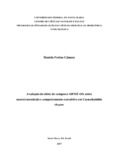| dc.creator | Câmara, Daniela de Freitas | |
| dc.date.accessioned | 2019-10-17T20:36:29Z | |
| dc.date.available | 2019-10-17T20:36:29Z | |
| dc.date.issued | 2017-03-06 | |
| dc.identifier.uri | http://repositorio.ufsm.br/handle/1/18613 | |
| dc.description.abstract | Epilepsy is characterized as an increased predisposition of the brain to generate recurrent seizures, which represent the effects of abnormal, excessive and hypersynchronous electrical discharges of cortical neurons. Currently, 65 million people in the world have epilepsy. However, 33% of the patients are refractory to the available treatments, making necessary the search for new drugs. Oxadiazois are heterocyclic compounds which the general formula C2H2ON2. The 1,3,4-oxadiazole isomer is one of the most known and studied, presenting a wide range of biological activities, such as antibacterial, antiviral, antifungal and anticonvulsant. In this work the effect of 2-[(4-methoxyphenylselenyl)methylthio]-5-phenyl-1,3,4-oxadiazole (MPMT-OX) on the cholinergic and GABAergic signaling in the nematode Caenorhabditis elegans was tested. The nematodes were exposed to 0, 5, 15 and 50 μM MPMT-OX from the L1 stage to young adults. The obtained results indicate that chronic exposure to MPMT-OX increased GABAergic signaling due to the regulation of unc-25 and unc-47 genes responsible for the synthesis and release of GABA in the synaptic cleft, respectively. The increase in inhibitory signaling attenuated the paralysis induced by pentylenetetrazol (PTZ) and aldicarb, drugs that promote hyperexcitation in neuromuscular junction. MPMT-OX increased the locomotor activity of nematodes with mutations in the unc-30, unc-46 and unc-49 genes (involved in the release and response to GABA). MPMT-OX also increased latency time to the onset of PTZ-induced seizure behavior and assisted in the recovery of the locomotor activity of these nematodes after exposure to PTZ. These data suggest that MPMT-OX represents a promising pharmacological agent in the treatment of conditions where the GABAergic system could be involved. | eng |
| dc.description.sponsorship | Coordenação de Aperfeiçoamento de Pessoal de Nível Superior - CAPES | por |
| dc.language | por | por |
| dc.publisher | Universidade Federal de Santa Maria | por |
| dc.rights | Attribution-NonCommercial-NoDerivatives 4.0 International | * |
| dc.rights.uri | http://creativecommons.org/licenses/by-nc-nd/4.0/ | * |
| dc.subject | Caenorhabditis elegans | por |
| dc.subject | GABA | por |
| dc.subject | Comportamento convulsivo | por |
| dc.subject | Pentilenotetrazol | por |
| dc.subject | Atividade locomotora | por |
| dc.subject | Seizure-like behavior | eng |
| dc.subject | Pentilenetetrazole | eng |
| dc.title | Avaliação do efeito do composto MPMT-OX sobre neurotransmissão e comportamento convulsivo em Caenorhabditis elegans | por |
| dc.title.alternative | Effect of the MPMT-OX compound on neurotransmission and convulsive behavior in Caenorhabditis elegans | eng |
| dc.type | Dissertação | por |
| dc.description.resumo | A epilepsia é caracterizada como uma predisposição aumentada do cérebro para gerar crises convulsivas recorrentes, que representam os efeitos de descargas elétricas anormais, excessivas e hipersincrônicas de neurônios corticais. Atualmente, 65 milhões de pessoas no mundo têm epilepsia. Contudo, 33% dos pacientes são refratários aos tratamentos disponíveis, se fazendo necessária a busca por novos fármacos. Oxadiazois são compostos heterocíclicos com fórmula geral C2H2ON2. O isômero 1,3,4-oxadiazol é um dos mais conhecidos e estudados, apresentando uma ampla gama de atividades biológicas, como antibacteriano, antiviral, antifúngico e anticonvulsivante. Neste trabalho testou-se o efeito do composto 2-fenil-5-[(4-metoxifenilseleno)metiltio]-1,3,4-oxadiazol (MPMT-OX) sobre a sinalização colinérgica e GABAérgica no nematoide Caenorhabditis elegans. Os nematoides foram expostos a 0, 5, 15 e 50 μM de MPMT-OX, a partir do estágio L1 até adultos jovens. Os resultados obtidos indicam que a exposição crônica ao MPMT-OX aumentou a sinalização GABAérgica devido à regulação dos genes unc-25 e unc-47, responsáveis pela síntese e liberação de GABA na fenda sináptica, respectivamente. O aumento da sinalização inibitória atenuou a paralisia induzida por pentilenotetrazol (PTZ) e aldicarb, drogas que promovem a hiperexcitação na junção neuromuscular. MPMT-OX aumentou a atividade locomotora de nematoides com mutações nos genes unc-30, unc-46 e unc-49 (envolvidos na liberação e resposta a GABA). MPMT-OX também aumentou o tempo de latência até o início do comportamento convulsivo induzido por PTZ e auxiliou na recuperação da atividade locomotora destes nematoides após exposição ao PTZ. Estes dados sugerem que o MPMT-OX representa um promissor agente farmacológico no tratamento de condições onde o sistema GABAérgico poderia estar envolvido. | por |
| dc.contributor.advisor1 | Soares, Félix Alexandre Antunes | |
| dc.contributor.advisor1Lattes | http://lattes.cnpq.br/8752453650114092 | por |
| dc.contributor.referee1 | Fighera, Michele Rechia | |
| dc.contributor.referee1Lattes | http://lattes.cnpq.br/8583392747509231 | por |
| dc.contributor.referee2 | Savegnago, Lucielli | |
| dc.contributor.referee2Lattes | http://lattes.cnpq.br/1480751214999787 | por |
| dc.creator.Lattes | http://lattes.cnpq.br/3291972918769847 | por |
| dc.publisher.country | Brasil | por |
| dc.publisher.department | Bioquímica | por |
| dc.publisher.initials | UFSM | por |
| dc.publisher.program | Programa de Pós-Graduação em Ciências Biológicas: Bioquímica Toxicológica | por |
| dc.subject.cnpq | CNPQ::CIENCIAS BIOLOGICAS::BIOQUIMICA | por |
| dc.publisher.unidade | Centro de Ciências Naturais e Exatas | por |



